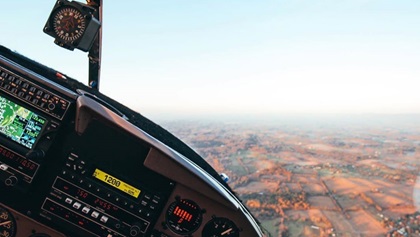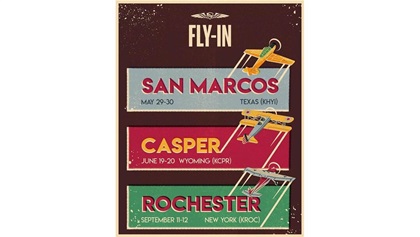
Insatiable appetite
Flight Training magazine to offer more premium content
By Kollin Stagnito
The Flight Training magazine team will begin producing more video and online content to provide readers with dynamic, interactive experiences that just aren’t possible in the magazine. Starting in January, annual Flight Training subscriptions include eight issues of Flight Training magazine, unrestricted access to AOPA’s redesigned online hub of premium aviation training content (accessible via aopa.org and the AOPA app), and the weekly Flight Training email newsletter.
Flight Training’s premium online content (available to subscribers only) will include articles, videos tips, animated technique illustrations, blogs, interactive quizzes, podcasts, and more to support students in their training—and enhance flying skills for those already in the air. Professional and career-track students will find a newly dedicated online section that contains a wealth of content and resources designed to support career goals—and an accelerated training timeline—which can be accessed at any time.
Flight Training’s weekly email newsletter will not only be the weekly guide to what’s new but will also remind readers of the extensive online training resources AOPA offers—including scholarships, series such as Technique and How It Works, the college directory, and so much more.
In addition to eight regular issues of the magazine, Flight Training will produce an annual You Can Fly special edition sent to flight schools across the country, and digitally to subscribers. The You Can Fly issue is a gift to new student pilots to welcome them to the pilot community and includes everything a student pilot needs to know to get started.
Flight Training has big plans for the new year, and we’re excited to fire up the GoPro cameras, press record on our audio equipment, and add some fun animation to our technique illustrations. You’ll be able to satisfy your insatiable appetite for training and safety content from Flight Training—because a good pilot is always learning.
Add a Flight Training subscription to your AOPA membership by calling 800-USA-AOPA (2672).
Email [email protected]
AOPA editor presented with lifetime achievement award
 AOPA Pilot Editor at Large Tom Horne received the 2019 David W. Ewald Platinum Wing Award for his lifetime achievement in journalism at the NBAA/GAMA convention. The Platinum Wing Award marks the contributions over a career in journalism that have made the business aviation industry a community and is named for the late David Ewald, who helped create Business & Commercial Aviation magazine and co-founded Flight Training magazine. Horne has been writing for AOPA publications for 40 years and is the editor of AOPA Pilot Turbine Edition. Horne is also an aviation weather expert. He wrote Flying America’s Weather and writes the “Wx Watch” articles in AOPA Pilot.
AOPA Pilot Editor at Large Tom Horne received the 2019 David W. Ewald Platinum Wing Award for his lifetime achievement in journalism at the NBAA/GAMA convention. The Platinum Wing Award marks the contributions over a career in journalism that have made the business aviation industry a community and is named for the late David Ewald, who helped create Business & Commercial Aviation magazine and co-founded Flight Training magazine. Horne has been writing for AOPA publications for 40 years and is the editor of AOPA Pilot Turbine Edition. Horne is also an aviation weather expert. He wrote Flying America’s Weather and writes the “Wx Watch” articles in AOPA Pilot.
AOPA Pilot magazine honored
AOPA Pilot, the world’s largest aviation magazine, recently received an Eddie Award for Series of Articles and an Ozzie Award for Cover Design at the Folio: Show in New York City.
The Eddie and Ozzie Awards, presented annually by Folio: Magazine, are among the most prestigious national awards in magazine publishing. Eddies recognize uncompromising journalism and Ozzies celebrate gorgeous design. The competition is open to all magazines—consumer, business-to-business, online, and associations—and this year received more than 2,500 entries.
AOPA Pilot won the Eddie for a series of articles on pilots who give back, including “Flying Them Home,” July 2018 by Julie Summers Walker; “Hope Flies,” September 2018 by David Tulis; “On Eagle’s Wings,” January 2019 by Julie Summers Walker; and “One Glorious Vision,” April 2019 by Thomas B. Haines. AOPA Pilot won the Ozzie for its May 2019 cover design featuring a Stearman flying over Wings Field in celebration of AOPA’s eightieth anniversary.
Earlier in 2019, AOPA Pilot and Flight Training magazines both were recognized by Association Media and Publishing with Bronze Excel Awards for general excellence. The video “Arnar’s World” by Senior Photographer Mike Fizer, which accompanied Thomas A. Horne’s story “Iceland Calls,” March 2018 AOPA Pilot, received a Gold Excel Award for Excellence.—KS
AOPA Air Safety Institute
All part of the system
How well do you really know your airplane?
By Alicia Herron
Aircraft systems are extremely reliable and can deliver years of safe flight when properly maintained. That being said, not all pilots know as much as they should about the proper care of the systems in their airplane. If your systems knowledge isn’t up to snuff, it’s time to sharpen up.
First, know your engine. Familiarity with engine basics will help you complete a more thorough preflight and runup on the ground and assess mechanical problems you may encounter in the air. Study the pilot’s operating handbook for your aircraft and keep up with all recommended maintenance. Maintenance is not optional—if you don’t take care of your airplane, how can you expect it to take care of you?
No carbureted engine is immune to carb ice. The window for carb ice is bigger than you might imagine—even hot days of a certain humidity can lead to perfect icing conditions in the carburetor. Don’t forget to check that the carb heat is functioning properly before you need it.
If you fly a fuel-injected engine, get familiar with the procedures for hot starting the engine. It likely will take practice and patience to become comfortable with a hot start, and that should begin with an understanding of what’s going on inside a fuel-injected engine. If you don’t know what vapor lock is, you won’t understand the steps behind a hot start and you might make potentially hazardous mistakes.
Next, know your propeller. Propellers, like engines, need regular maintenance and overhauls. Consider adding a check of the propeller during oil changes.
Brief your passengers on the importance of avoiding the propeller—ideally before arriving at the airplane. Also, regularly verify that the magnetos are grounding properly and that you don’t have a hot mag. If a grounding check isn’t already in your shutdown checklist, consider adding it. Avoid dragging the airplane around by the propeller—just in case you do have a hot mag. Too much stress from pulling can also damage the prop, and repairs in aviation are rarely to never cheap.
Finally, know your pneumatic system. Pneumatic systems fail. Expect it and be prepared. Consider installing a backup and a prominently placed annunciator, especially if you fly in instrument conditions or VFR at night.
Every system on board your aircraft is critical—engines, propellers, and pneumatic systems are just the beginning. Understand and keep them all well maintained to make your flying safer.
Web: airsafetyinstitute.org/safetyadvisor/aircraftsystems
Email [email protected]
Fly with AOPA
On your feed
 Prepare for the new flying season!
Prepare for the new flying season!
Carbon monoxide season is here; make sure to get new monitors if yours is expired or replace the batteries on your electronic ones. #flywithaopa
 Better late than never
Better late than never
Installing the uAvionix tailBeacon on a Navion. Watch as Richard McSpadden (@spadmcspadden) from the AOPA Air Safety Institute finally installs the #uAvionix tailBeacon on his Navion.
Looking for more?
Instagram: @flywithaopa, Twitter: @aopa, Facebook: AOPA: Your Freedom to fly, AOPA Live
 Post of the month
Post of the month
AOPA Fly-Ins
2020, we’re ready for you. #flywithaopa #2020
Web: aopa.org/fly-ins
Tag @flywithaopa for your chance to be featured on this page!

Member Products and Services
Crossing the border
Intrusive searches are Fourth Amendment violations
By Chad Mayer
When traveling internationally, either by general aviation or other means, it’s important to be aware of your rights and the government’s authority at the border. In a recent decision in the ongoing Alasaad v. McAleenan case, a U.S. District Court held that suspicionless border searches of personal electronic devices such as cellphones and laptops are an unconstitutional violation of the Fourth Amendment. International airports and ports of entry are considered the “functional equivalent” of an international border, so the same rights and authorities are in play when physically crossing the border as when encountering agents from Customs and Border Protection (CBP) or Immigration and Customs Enforcement (ICE) at an airport.
The lawsuit stems from intrusive searches by CBP and ICE of the devices of several U.S. citizens and one lawful permanent resident. These searches included manually looking through data such as pictures and text messages contained on the devices, and in some cases copying and retaining data from the devices through wireless or wired connections to government equipment. Routine or cursory searches, such as searches to determine merely that a device can power on and contains data, are not affected by the ruling.
It is well understood that the government has broad authority at the border to support its interest in excluding contraband and people ineligible to enter. By the same token, the court found that “individuals have a reduced expectation of privacy at the international border.” In weighing the legitimate governmental interest against the intrusion upon the individuals’ privacy, the court determined that agents must have reasonable suspicion before conducting a search of personal electronic devices involving accessing data. That standard is met when agents “can point to specific and articulable facts” that, based on rational inferences from those facts as well as the agents’ “training and experience,” give rise to reasonable suspicion that the devices to be searched contain contraband.
The reasonable suspicion standard is well below the more familiar probable cause standard, and there is no requirement for agents to obtain a warrant to search personal electronic devices at the border. Nevertheless, the ruling does change the status quo by making it impermissible to conduct such a search without at least a particularized suspicion about the contents of the device.
Web: aopa.org/pps
Chad Mayer is is an in-house attorney for the AOPA Legal Services Plan.
Tips from PIC
Part 61 or 141?
By Andy Dimitriou
There are two types of primary flight training schools: Part 61 and Part 141.
Part 61 of the federal aviation regulations details pilot certifications. Part 141 details flight schools with appendices specifying pilot certification requirements. A Part 141 school must receive FAA approval for its training curriculum, syllabus, and lesson plans, creating a more structured environment. The FAA reviews these on a regular basis.
Each Part 141 program is uniquely designed and managed by the chief instructor. Specific ground and flight training requirements for graduation must be documented. The Part 61 training environment is less strict, allowing an instructor more flexibility in his or her training approach. Upon completion of training under either part, the student is tested by the FAA to the same standards.
Because of the more structured program and the annual FAA review, the Part 141 school can offer a certificate with fewer flight hours. For example, a private pilot certificate requires a minimum of 40 flight hours under Part 61, but only 35 hours under Part 141. In addition, the commercial pilot certificate can be accomplished in 190 flight hours at a Part 141 school, as opposed to 250 hours under Part 61.
Part 141 approval is challenging. Ground and flight training must be documented and tracked for verification and progress. Typically, an 80-percent pass rate is required to retain the certificate. The school can develop its own curriculum or use a commercially available FAA approved online program. Call AOPA Monday through Friday, 8:30 a.m. to 6 p.m. Eastern time, at 800-USA-AOPA, or email [email protected]
Andy Dimitriou is an AOPA aviation technical specialist.


